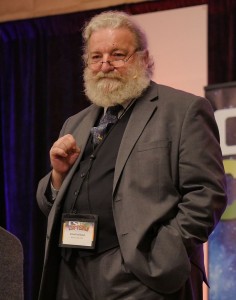Questions & Answers: David Helfand on combating misinformation
From an Article by Melinda Baldwin, Physics Today, December 28, 2016
The Columbia University astronomer thinks we’re living in an age of inaccuracies—but that science may hold the key to our survival.
“Throughout human history, information has been limited, difficult to access, and expensive,” writes Columbia University astronomer and educational innovator David Helfand in the introduction to his book A Survival Guide to the Misinformation Age: Scientific Habits of Mind. “We now occupy the opposite state: information is virtually unlimited but often of very low reliability.”
In his book, reviewed this month in Physics Today, Helfand argues that “scientific habits of mind,” which include performing back-of-the-envelope calculations and understanding the difference between correlation and causation, can help overwhelmed citizens distinguish between good and bad information. Helfand, a former president of Quest University Canada in Squamish and a past president of the American Astronomical Society (AAS), has put his pedagogical and scientific skills to use in the hope that his book will provide an “antidote to the misinformation glut.”
Physics Today recently caught up with Helfand to discuss the survival guide.
PT: What motivated you to write this book?
HELFAND: Even before the US election and Facebook CEO Mark Zuckerberg’s hand-wringing about fake news, there were already plenty of reasons to be concerned about the propagation of misinformation in our society. The internet provides a free and virtually unlimited opportunity to spread disinformation and misinformation. It also grants users the power to shape their “information” diet so that it only reinforces preconceived notions and confirms their group identity. As Frank Bruni wrote in the New York Times, the internet allows us to “construct precisely contoured echo chambers of affirmation that turn conviction into zeal, passion into fury, disagreements with the other side into the demonization of it.” This in turn leads to bad personal decision making and completely cripples the formation of rational public policy. I felt an antidote was urgently needed.
PT: Which common misunderstandings or misinformation do you, as a scientist, find particularly baffling or frustrating?
HELFAND: It is difficult to know where to begin. How about the belief that the MMR vaccine causes autism, based on a fraudulent paper published in the UK 18 years ago. That paper has been retracted by the journal, the author has been stripped of his license to practice medicine in the UK (so he moved to Texas), and numerous competent, double-blind studies have shown the claim to be false. Nonetheless, with support from so-called medical experts and innumerable websites, thousands of highly educated, successful, and wealthy parents put their own and other children at risk because of their “personal belief” in this arrant nonsense. Or we could cite the fact that more than 5 million Americans spend over $3 billion a year on homeopathic “medicine,” which is, by definition, indistinguishable from pure water. Or ― well, I could fill this magazine with examples, but I’ll save some for those who read the book.
PT: Can scientists work to discredit misinformation, and if so, how?
HELFAND: Yes, but it is not easy work. And first it is crucial to make sure our own house is in order. Some years ago Amgen spent a lot of time and money trying to replicate 53 “breakthrough” preclinical and clinical studies of cancer drugs and found that 47 of the studies (89%) were irreproducible. Recently Brian Nosek at the University of Virginia led an effort to replicate the results of 100 psychology experiments described in peer-reviewed publications; two-thirds were irreproducible. An academic culture that allows—even promotes—these outcomes undermines the credibility of science.
Furthermore, when conveying scientific conclusions to an audience of nonscientists, it is essential that we distinguish facts (measurements of the material world with their associated uncertainties) from models and predictions. As Bill Press said in a recent address to AAS, it is important when communicating with the public that we separate the fact-discovery mechanism of science from the values of science (reliance on evidence, logical reasoning, and so on). I, like most scientists, treasure both, but people don’t like to be preached at concerning their values. Thus I think we need to be very careful in how we go about communicating our scientific understanding of the world.
PT: You include two “interludes” in the book—one on “Numbers” and another on “Logic and Language.” How do these topics relate to the habits of mind your book seeks to cultivate?
HELFAND: It is my view that a respect for numbers and the precise use of language are essential first steps in cultivating the habits of mind necessary to combat misinformation. The mainstream media misuse numbers every day. A billion and a trillion are just big numbers to most journalists and the public they misinform, but it matters whether a tax proposal costs $4 billion or $4 trillion. And incidentally, why was it decided that the appropriate way to price any piece of legislation is over a decade, far beyond the predictive horizon of economists, making the numbers meaningless?
PT: What is your next project?
HELFAND: I plan to write a book on the myriad uses of both stable and radioactive isotopes in the reconstruction of history. From art forgeries to archaeology, the history of human diet to paleo-climatology, and the evolution of the solar system to the universe itself, physicists have developed a number of fascinating techniques that allow a quantitative reconstruction of past events. The idea is to recount, in a series of detective stories, how tiny isotopic differences allow us to establish that a painting is a fake or to chart the spread of maize cultivation across the Americas.
See also: www.FrackCheckWV.net

